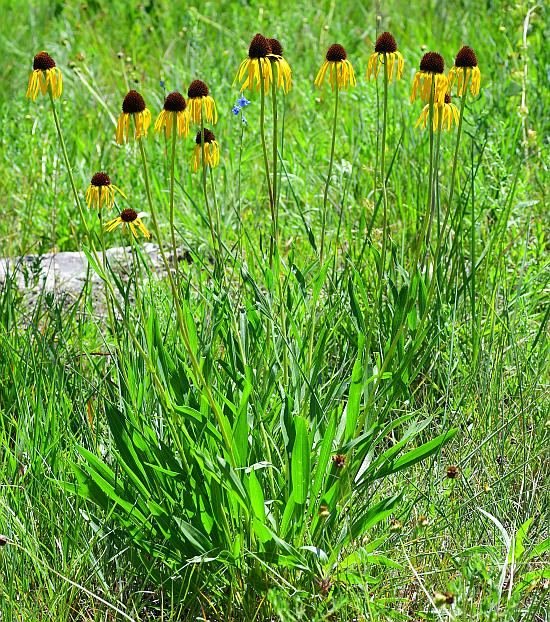Echinacea paradoxa (Norton) Britton
Yellow Coneflower

Native
CC = 9
CW = 5
MOC = 24
© SRTurner
Echinacea paradoxa (Norton) BrittonYellow Coneflower | |
 |
Native CC = 9 CW = 5 MOC = 24 |
© SRTurner |
|
Family - Asteraceae/Heliantheae Habit - Perennial forb with a usually elongated, vertical rootstock and often somewhat tuberous main roots, sometimes also with short, stout rhizomes. Stems - Ascending to erect, to 90 cm, multiple from base, usually unbranched, sparsely to moderately pubescent with stiff, appressed or ascending, broad-based hairs.
Leaves - Mostly basal, alternate, lowest petiolate, becoming sessile above. Petioles to 25 cm long. Leaves with the margins entire and usually pubescent with loosely appressed hairs, the surfaces moderately to densely pubescent with stiff, appressed to loosely appressed, sometimes minutely pustular-based hairs, slightly to moderately roughened to the touch, with 3 or 5 main veins. Basal leaves 8-45 cm long, the blade narrowly elliptic to narrowly lanceolate, oblong-lanceolate, or lanceolate, mostly 5-20 times as long as wide, long-tapered or narrowly angled at the base. Stem leaves 4-35 cm long, linear to narrowly elliptic or narrowly lanceolate, otherwise similar to the basal leaves. Leaves quickly reduced upward and absent on upper 2/3 of stem.
Inflorescence - Single flower head terminating stem. Heads - Involucral bracts in 2-3 series, 7-12 mm long, the outer surface glabrous (except along the margins) or sparsely pubescent with mostly appressed hairs, not glandular. Receptacle 2.0-3.5 cm in diameter, the chaffy bracts 9-14 mm long, hardened, usually reddish purple or orange toward the tip, exceeding the disk florets.
Flowers - Rays florets sterile, the corollas 3-7 cm long, 5-8 mm wide, reflexed or drooping at flowering, 3-toothed at apex, glabrous, yellow. Disc florets fertile, the corollas 4-6 mm long, the tube and lobes lobes brownish. Pappus a minute crown or absent. Pollen yellow when fresh.
Fruits - Achenes 3-angled, winged on margins, 4.0-5.5 mm long.
Flowering - May - June. Habitat - Calcareous glades, upland prairies, savannas, roadsides, bald knobs. Also cultivated. Origin - Native to the U.S. Lookalikes - None close. Other info. - This striking species is relatively uncommon. The var. paradoxa which occurs in Missouri is nearly endemic to Missouri. It is found in a cluster of counties toward the center of the state and southwestward, and also a few counties in northern Arkansas. It is also cultivated. The plant is typical of the genus except for its brilliant yellow ray ligules. It is easily identified in the field from its long thin leaves and big conic disk. Photographs taken off Hwy 60, Van Buren, MO., 5-26-03, and at Busiek State Forest, MO., 6-17-05 (DETenaglia); also at Shaw Nature Reserve, Franklin County, MO, 6-13-2021, and Glade Top Trail National Scenic Byway, Ozark County, MO, 8-15-2023 (SRTurner). |